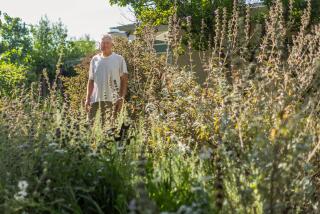Quiet the buzz saws and await the first sweet songs of the season
- Share via
After THE RAINS, BIRD song. From the quick zeet zeets of the hummingbirds to the low sweet calls of mourning doves, the sounds of bird-nesting season are here. In protecting them, never is the art of gardening less about power and more about sympathy.
Flickers, those woodpeckers identifiable by their muscular flight rhythm (flap, flap, flap and coast) and golden underwings, course the sky. Warblers are in full song, Phoebes too, overdressed with their tux-like chests. But the birds that truly herald spring come in chattering clouds. They are the bushtits.
From a distance, tits are drab, gray-brown, so small they could be hummingbirds, except they have rounded chests, they cheep instead of zeet and tick, and instead of a zipping flight pattern, they throw themselves into flight, dropping with the joyous aplomb of a skydiver, then catching themselves for a bobbing flight. They arrive in chittering packs, then every spring, these charming acrobats divide up into families to nest.
For years, I wondered where they brooded. In spite of their noisy arrival, I elected to believe the foremen of my garden crews that spring pruning would not affect them. Looking back, theirs was a practiced deception and mine complicit ignorance.
Cap in hand, the foremen would look me straight in the eye and say, “Oh, no, lady, we never touch nests. We love birds.” Then they would point to the obvious crooks in the acacia’s limbs, where only a crow’s nest the size of a punchbowl would fit, and say, “See? No nests.”
“Oh, good,” I’d mumble.
Then, the year before last, I stopped the saws. Only one season later, I finally saw bushtits make a nest. Just like hummingbirds, they built it at the outermost extreme of a branch. In a hedge, this is just at the point where the buzz saws grind the new shoots; in a tree, where trimmers cut from the center, even the most conscientious arborist is likely to miss a nest, before the limb goes crashing to the ground. Bushtits nest so far out because before buzz saws, this was the safest spot in the tree, out of reach of squirrels, larger birds and cats.
As construction of the nest in my acacia began, the mating bushtits took extravagant care to elude predators. The parents carrying twigs would light far from the nesting spot in an acacia tree, then hop surreptitiously toward the building site, turning sideways, backwards, checking a new angle with every bounce. In New York, I used to see drug dealers back into abandoned buildings with much the same sort of theatrical watchfulness.
As the nest appeared, it was almost indistinguishable from the tree, a kind of suspended sack, so well-woven into the end of the branch that it could have been more leaves. The situation looked precarious, but in fact, it was so well built, it hangs there still, a year later.
Once the eggs hatched, the parents still kept backing in as if it were a crack den, but by this point, their secrecy was wishful. There’s no quieting a nest full of hungry bushtit chicks when a parent arrives full of half-digested scale, or whatever constitutes their particular pabulum.
The parents of these chicks seemed to be gleaning a pair of English roses growing a mere drop from their nest.
Puree of spider mite, anyone?
If I had needed a reason not to spray roses, this was it. The chicks’ hunger was such, every plant was groomed. They cleared the citrus of scale (no pore-clogging oil needed), the hibiscuses of white fly.
To enlist the pest control services of bushtits, there are sacrifices. One has to prune trees in the autumn, and absolutely still the saws and take leave of the shears from February to July. This means forsaking crew-cut hedges in favor of a more Byron-esque look.
Myself, I like shaggy. For those who don’t, there are unseen rewards. Pruning during spring stresses plants. The sap is rising, so they “bleed” more, poor xylem, poor phloem. Fungus is an issue in rainy season and open cuts exacerbate the risk. All in all, this time of year, a better place to expend energy is sowing arugula and lettuce seeds, and, if you haven’t already, planting artichokes.
By July, it will be salad days. Over lunch in the garden, stop, listen, sigh, then raise a glass to the most sublime reward. You won’t be worrying about pesticides because you won’t have used any, and your garden will ring with bird song instead of buzz saws.
*
Recommended
Need help distinguishing a bushtit or a hummingbird? The following resources can help you identify some sounds of spring in your garden:
“The Sibley Field Guide to Birds of Western North America” by David Allen Sibley, Turtleback, $19.95.
Los Angeles Audubon Society, 7377 Santa Monica Blvd., West Hollywood, CA 90046; (323) 876-0202; www.laaudubon.org.
More to Read
Sign up for The Wild
We’ll help you find the best places to hike, bike and run, as well as the perfect silent spots for meditation and yoga.
You may occasionally receive promotional content from the Los Angeles Times.






